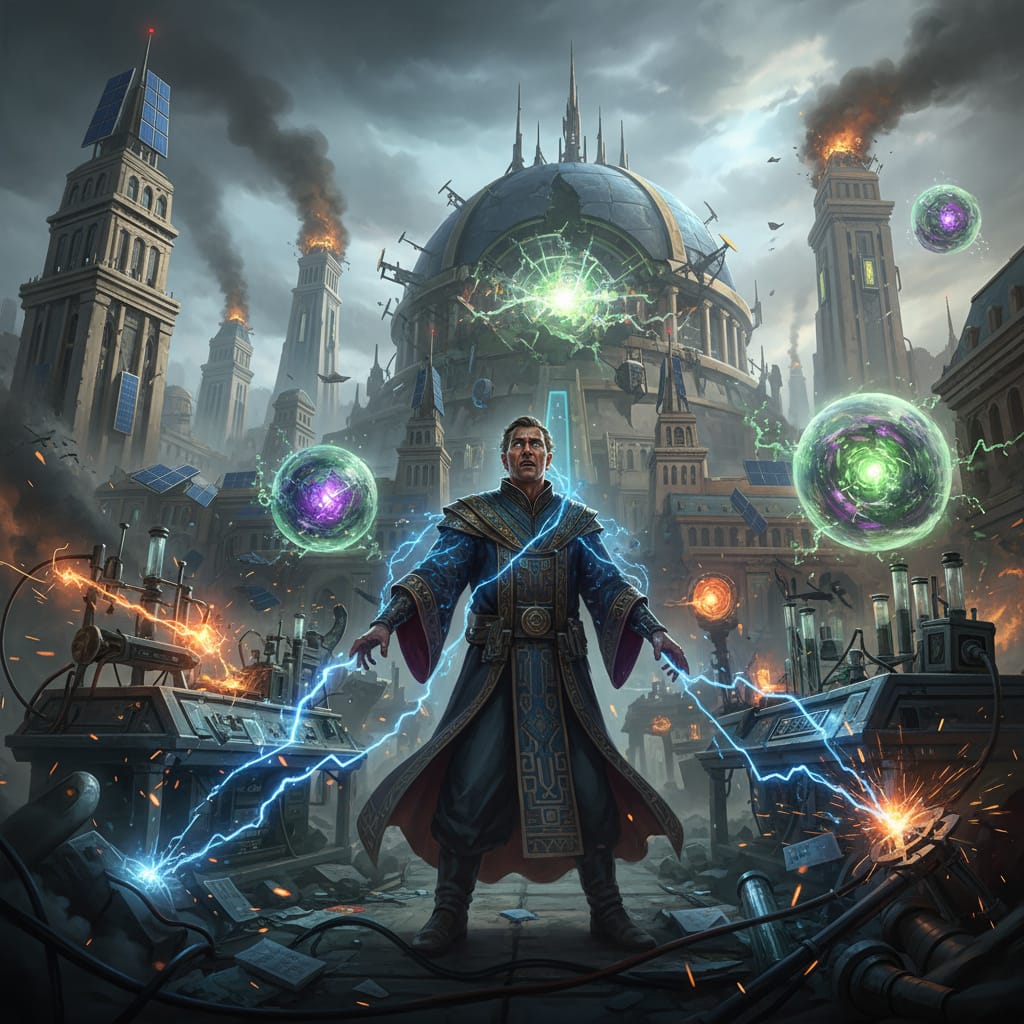The pursuit of knowledge in Civilization VI is a relentless, linear march toward progress. Great Scientists, the catalysts of this advancement, are reliable servants, appearing on cue to bestow their wisdom with predictable certainty. But what if the spark of genius was also a potential powder keg? This is the question explored in depth across community forums and strategy discussions: what if activating a Great Scientist carried a risk, a chance of a catastrophic “lab accident” that could cripple the very city fostering innovation? This single change would ripple through every layer of strategy, transforming the straightforward race for science into a high-stakes game of risk management.
Analysis on forums shows that such a mechanic would force a fundamental re-evaluation of how players approach scientific advancement. No longer would Great Scientists be a simple “click for bonus” affair. Instead, their activation would become a calculated gamble, a moment of tension where the potential for a massive leap forward is weighed against the threat of a devastating setback. Many professional gamers suggest that this would not only add a new layer of strategic depth but also create more dynamic and unpredictable gameplay, where even the most dominant science-focused civilization could be brought to its knees by a stroke of bad luck.
This guide delves into the strategic implications of a hypothetical “lab accident” mechanic for Great Scientists in Civilization VI. We will explore the potential consequences of such accidents, the new strategies that would emerge to mitigate these risks, and the overall impact this would have on game balance and the pursuit of a science victory.
The Nature of the Catastrophe: Potential Lab Accidents
According to the player community, the “lab accident” mechanic would need to be more than just a simple penalty. To be truly engaging, it would need to be a spectrum of potential disasters, ranging from minor inconveniences to city-crippling catastrophes. The severity of the accident could be tied to the era, with later-era scientists, wielding more potent and volatile knowledge, having a higher chance of causing a more significant disaster.
Minor Setbacks: A Spanner in the Works
At the lower end of the spectrum, a lab accident might manifest as a temporary disruption. A popular strategy is to have a range of minor negative outcomes that would slow down a player’s progress without being completely debilitating. These could include:
- Damaged Campus Buildings: The most direct consequence would be damage to the Campus district itself. A “small explosion” could damage the Library or University, requiring production to repair. This would not only divert production from other projects but also temporarily reduce the city’s science output.
- Loss of Population: A more serious accident could result in the loss of one or two population in the city. This represents the human cost of scientific overreach and would have a direct impact on the city’s overall yields.
- Temporary Yield Reduction: The accident could cause a temporary reduction in the city’s science, production, or even food output for a set number of turns. This would simulate the disruption and chaos caused by the accident, forcing the player to adapt to a temporary setback.
Major Catastrophes: A City on the Brink
While minor setbacks would add a new layer of challenge, the real strategic depth of this mechanic would come from the possibility of major, city-altering disasters. Many professional gamers suggest that these high-risk, high-reward scenarios would be the true test of a player’s adaptability.
- District Destruction: A truly catastrophic accident could result in the complete destruction of a random district in the city. While the Campus would be the most thematic target, the random nature of the destruction would add an element of terrifying unpredictability. Losing a fully developed Industrial Zone or a crucial Commercial Hub could be a devastating blow.
- Strategic Resource Contamination: An accident involving volatile materials could contaminate a nearby strategic resource, making it unusable for a long period or even permanently. This would be particularly impactful in the late game, where resources like Uranium and Aluminum are essential for a science victory.
- The “Rogue Element”: A popular strategy is to introduce a “rogue element” as a result of the accident. This could be a powerful barbarian unit that spawns near the city, representing a failed experiment that has broken loose. This would force the player to divert military attention to deal with the threat, adding a new layer of complexity to their strategic planning.
New Strategies in a World of Unstable Science
The introduction of a “lab accident” mechanic would necessitate a complete overhaul of how players approach the science game. The once-safe path to a science victory would be fraught with peril, and new strategies would emerge to navigate this treacherous landscape.
The Rise of the “Safety Officer”: Mitigating the Risk
According to the player community, the most immediate strategic shift would be the development of risk mitigation strategies. Players would actively seek out ways to reduce the chance of a lab accident or minimize its impact.
- New Policy Cards and Government Choices: A popular strategy is to introduce new policy cards that would reduce the chance of a lab accident. These cards would likely come with a trade-off, such as a slight reduction in overall science output, forcing players to make a strategic choice between speed and safety. Certain government types, such as a Technocracy, might also offer inherent bonuses to lab accident mitigation.
- The “Safety First” Governor: A new governor, or a promotion for an existing one like Pingala, could be introduced with a focus on scientific safety. This governor could have abilities that reduce the chance of an accident, or even completely negate the first accident in a city.
- Strategic City Specialization: Players might choose to designate a single, highly specialized “research city” where they activate all their Great Scientists. This city would be heavily fortified with all available risk mitigation measures, effectively becoming a “blast chamber” for scientific experimentation. This would be a high-risk, high-reward strategy, as a major accident in this city could be catastrophic, but it would protect the rest of the empire from the dangers of unstable science.
The “Mad Scientist” Gamble: Embracing the Chaos
While many players would focus on mitigating the risks, others would undoubtedly embrace the chaos. Many professional gamers suggest that a “lab accident” mechanic would create new opportunities for high-risk, high-reward gameplay.
- The “Volatile” Great Scientists: Certain Great Scientists could be designated as “volatile,” with a higher chance of causing an accident but also a more powerful effect. This would create a strategic choice for players: do they take the risk for a massive leap forward, or do they play it safe with a more stable, but less impactful, scientist?
- The “Disaster for Profit” Strategy: A popular strategy is to find ways to turn a disaster into an opportunity. For example, a lab accident could create a new, unique tile improvement on a damaged tile, or it could trigger a “Eureka” moment for a related technology. This would add a layer of strategic depth to the recovery process, as players would look for ways to capitalize on the chaos.
- Targeting a Rival’s Research City: The “research city” strategy could also be turned into a weapon. A player could use spies to sabotage a rival’s research city, increasing the chance of a lab accident and potentially crippling their scientific progress. This would add a new dimension to espionage and make the science race even more competitive.
The Ripple Effect: Impact on Game Balance
The introduction of a “lab accident” mechanic would have a profound impact on the overall balance of Civilization VI. It would touch every aspect of the game, from civilization and leader choices to the viability of different victory conditions.
Rebalancing the Science Victory
Analysis on forums shows that the science victory is often seen as one of the most straightforward and predictable victory conditions in the game. A “lab accident” mechanic would shatter this predictability, making the science victory a much more dynamic and challenging pursuit.
- Slowing Down the Snowball: The science victory often involves a “snowball” effect, where a civilization with an early science lead can quickly pull away from the rest of the pack. A “lab accident” mechanic would act as a natural brake on this snowball, as a major accident could set back even the most dominant science player.
- The Importance of a Balanced Empire: A popular strategy is to focus heavily on science and production to achieve a science victory. A “lab accident” mechanic would force players to adopt a more balanced approach, as they would need a strong military to deal with potential “rogue elements” and a healthy economy to recover from disasters.
- New Paths to a Science Victory: The mechanic could also open up new, alternative paths to a science victory. For example, a civilization that focuses on risk mitigation and stability might be able to outpace a more reckless, high-risk rival in the long run.
Civilization and Leader Re-evaluation
The “lab accident” mechanic would also force a re-evaluation of the strengths and weaknesses of different civilizations and leaders.
- The Rise of the “Safe” Civilizations: Civilizations with bonuses to production, stability, or disaster recovery would become much more attractive for a science victory. For example, Germany’s production bonuses would be invaluable for repairing damaged districts, while Egypt’s ability to build districts and wonders faster would help them recover from a catastrophic accident.
- The “High-Risk, High-Reward” Leaders: Leaders with a more aggressive or risk-taking playstyle could also find new opportunities with this mechanic. For example, a leader like Hammurabi, who can already unlock technologies at an accelerated rate, could become even more powerful if they are willing to take the risk of a lab accident for a massive scientific breakthrough.
- New Leader Abilities: The mechanic could also inspire new leader abilities that interact with the “lab accident” system. A leader could have an ability that reduces the chance of an accident, or even one that allows them to “steer” the outcome of an accident to their advantage.
A More Dynamic and Unpredictable Future
The introduction of a “lab accident” mechanic for Great Scientists in Civilization VI would be a transformative change, injecting a much-needed dose of risk and unpredictability into the pursuit of a science victory. It would force players to think more strategically about their scientific advancements, weighing the potential for a massive leap forward against the threat of a devastating setback. New strategies would emerge, from cautious risk mitigation to reckless “mad scientist” gambles, and the overall balance of the game would be shifted in exciting and unexpected ways.
While this is all hypothetical, the depth of discussion and analysis from the player community shows a clear desire for more dynamic and engaging gameplay mechanics. A “lab accident” system, with its potential for both triumph and disaster, would be a perfect fit for a game that is already about navigating the unpredictable currents of history. It would be a constant reminder that the path to progress is never a straight line, and that even the most brilliant minds can sometimes unleash forces beyond their control.


